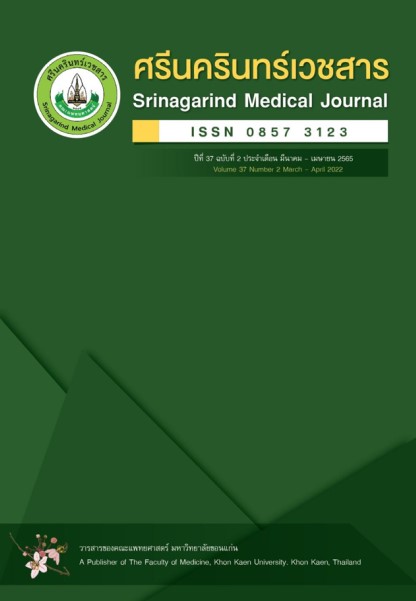การฉีดโบทูลินัม ท็อกซินรักษาผู้ป่วยที่มีภาวะน้ำลายขังใต้ชั้นผิวหนังและภาวะน้ำลายไหลจากรูรั่วที่ผิวหนังจากต่อมน้ำลายพาโรติด
Abstract
Botulinum Toxin Injection in Parotid Sialocele and Parotid Sialocutaneous Fistula
หลักการและวัตถุประสงค์: ภาวะน้ำลายขังใต้ชั้นผิวหนังและภาวะน้ำลายไหลจากรูรั่วที่ผิวหนังจากต่อมน้ำลายพาโรติดพบได้น้อย แต่รบกวนคุณภาพชีวิตของผู้ป่วยมาก สาเหตุหลักเกิดภายหลังการผ่าตัดต่อมน้ำลายพาโรติด ปัจจุบันมีการรักษา โดยฉีดโบทูลินัม ท็อกซินเข้าในต่อมน้ำลายพาโรติด เพื่อลดการหลั่งน้ำลาย แต่ข้อมูลการรักษายังมีจำกัด การศึกษานี้มีวัตถุประสงค์เพื่อศึกษาลักษณะทางคลินิกของผู้ป่วย และผลการรักษาโดยการฉีดโบทูลินัม ท็อกซินในผู้ป่วยสองภาวะนี้
วิธีการศึกษา: การศึกษาเชิงพรรณนาแบบย้อนหลัง โดยทบทวนเวชระเบียนของผู้ป่วยที่มีภาวะน้ำลายขังใต้ชั้นผิวหนัง และ/หรือ ภาวะน้ำลายไหลจากรูรั่วที่ผิวหนังจากต่อมน้ำลายพาโรติด ที่ได้รับการรักษาโดยฉีดโบทูลินัม ท็อกซิน ที่โรงพยาบาลศรีนครินทร์ ระหว่างวันที่ 1 มกราคม พ.ศ.2554 ถึง 30 มิถุนายน พ.ศ.2564
ผลการศึกษา: พบผู้ป่วย 6 ราย ที่มีภาวะน้ำลายขังใต้ชั้นผิวหนัง และ/หรือ ภาวะน้ำลายไหลจากรูรั่วที่ผิวหนังจากต่อมน้ำลายพาโรติด ภายหลังการผ่าตัดต่อมน้ำลายพาโรติด และผู้ป่วย 1 ราย ที่พบสองภาวะนี้ร่วมกันภายหลังการถูกของมีคมบาดบริเวณใบหน้า ผู้ป่วยทุกรายได้รับการรักษาโดยการฉีดโบทูลินัม ท็อกซินเข้าในต่อมน้ำลายพาโรติดที่เหลืออยู่และทำแผลแบบกด ปริมาณเฉลี่ยสุทธิของโบทูลินัม ท็อกซินต่อคน คือ 30 ยูนิต (20-50 ยูนิต) ระยะเวลาเฉลี่ยในการหายของภาวะน้ำลายไหลจากรูรั่วที่ผิวหนัง คือ 14 วัน (5-30 วัน) หลังฉีดยา ผู้ป่วยทุกรายหายขาดจากการฉีดยาเพียงครั้งเดียวและไม่พบการกลับเป็นซ้ำ
สรุป: การฉีดโบทูลินัม ท็อกซินร่วมกับการทำแผลแบบกดในการรักษาผู้ป่วยที่มีภาวะน้ำลายขังใต้ชั้นผิวหนังและภาวะน้ำลายไหลจากรูรั่วที่ผิวหนังจากต่อมน้ำลายพาโรติด เป็นวิธีการรักษาที่ทำได้ง่าย มีประสิทธิภาพดี และมีผลข้างเคียงน้อย ผู้วิจัยแนะนำให้ฉีดโบทูลินัม ท็อกซินภายใน 6 สัปดาห์ หลังเริ่มมีภาวะนี้
คำสำคัญ: โบทูลินัม ท็อกซิน; ภาวะน้ำลายขังใต้ชั้นผิวหนัง; ภาวะน้ำลายไหลจากรูรั่วที่ผิวหนัง; ต่อมน้ำลายพาโรติด
Background and objective: Although parotid sialocele and parotid sialocutaneous fistula are rare in occurrence, they greatly affect patients' quality of life. The main cause of these conditions is the complication after parotidectomy. In recent years, one of the noninvasive treatments that have been increasing recognition is botulinum toxin (BT) injection in remaining parotid tissue but there is still a lack of data. This study aimed to assess the clinical characteristics of patients and effectiveness of BT in the management of these conditions.
Method: A retrospective descriptive review of patients who had been treated with BT for parotid sialocele and/or parotid sialocutaneous fistula at Srinagarind hospital from 1st January 2011 to 30th June 2021.
Result: Six patients developed parotid sialocele and/or parotid sialocutaneous fistula after parotid gland surgery and one developed both of these conditions after having a penetrating injury involving the parotid area. All patients were treated by injection of BT into the remaining parotid tissue with a post-injection pressure dressing. The average dosage of BT was 30 units (20-50 units). The mean duration of fistula healing after BT injection was 14 days (5-30 days). Complete healing was achieved after the single injection of BT in all patients. No side effects and recurrence were observed.
Conclusion: BT injection with a pressure dressing in the patient with parotid sialocele and parotid sialocutaneous fistula is not difficult, safe and highly effective. We recommend an early injection of BT within 6 weeks after the development of these conditions.
Keywords: Botulinum toxin; Sialocele; Sialocutaneous fistula; Parotid gland


